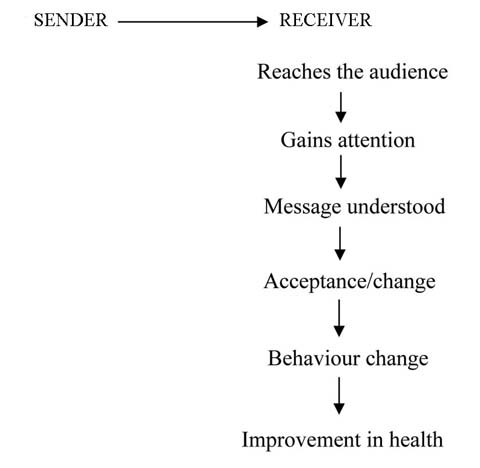8.4 Stages of health communication
In health education and health promotion you communicate for a special purpose — to promote improvement or change in health through the modification of the factors that influence behaviour. To achieve these objectives, successful communication must pass through several stages (Figure 8.6):

Stage 1 Reaching the intended audience
Communication cannot be effective unless it is seen or heard by its intended audience. A common cause of failure at this stage is ‘preaching to the converted’. An example of this would be if posters asking people to attend for antenatal care are placed at the clinic itself only, or talks on the subject are only given at antenatal clinics. These methods only reach the people who are already motivated to use the service. However the groups you are trying to reach may not attend clinics, nor have radios or newspapers. They may be busy at the times the health education programmes are broadcast on the radio. Communication should be directed where people are going to see or hear the messages (Figure 8.7). This requires careful study of your intended audience to find out where they might see posters or what their listening and reading habits are.

Stage 2 Attracting the audience’s attention
Any communication must attract attention, so that people will make the effort to listen or read the information. Examples of failure at this stage are:
- Going past the poster without bothering to look at it (Figure 8.8).
- Not paying attention to the health talk or demonstration at the clinic.
- Turning off the radio programme or switching over to another channel.

Stage 3 Understanding the message
Once the person pays attention to a message they will try to understand it. For example, two people may hear the same radio programme or see the same poster and interpret the message quite differently from each other — and differently from the meaning intended by the sender. A person’s interpretation of a communication will depend on many things.
Failure at this stage can take place when:
- Complex language and unfamiliar or technical words are used
- Pictures contain complicated diagrams and distracting details
- Pictures contain unfamiliar or strange subjects
- Too much information is presented and people cannot absorb it at all.
Stage 4 Acceptance of change
A communication should not only be received and understood — it should be believed and accepted.
It is usually easier to promote a change when its effects can be easily demonstrated. For example, ventilated improved pit latrines do not smell and will be more accepted by the community because of this feature.
Stage 5 Producing behaviour change
A communication may result in a change in beliefs and attitudes, but still not influence behaviour or action. This can happen when the communication has not been aimed at the factor that has most influence on the person’s behaviour. For example a person may have a favourable attitude and want to carry out the action, such as using family planning — but some people around may prevent the person from doing it. Sometimes the person might not have the means (enabling factors) such as money, skill or availability of services to take action. As a result there will be no behaviour change.
Stage 6 Improvement in health
Improvement in health will only take place if the changed behaviours have been carefully selected so that they really influence health. If your messages are based on outdated or incorrect ideas, people could follow your advice — but their health would not improve.
In a community dialogue some people were convinced of the importance of having a latrine and wanted to build one in their village. But they didn’t have any material for construction. Look back at the communication stages. At what communication stage has the message failed?
The message has failed at stage 5, which is the stage of producing a behaviour change. This is because not only are changes in beliefs and attitudes needed but enabling factors such as the availability of resources are also necessary.
Now look at Table 8.1(a) which shows some examples of failure at different stages of the communication process. Read each one and then write down an action in the third column that you think would lead instead to success.
Table 8.1(a) Examples of failure at different communication stages. Stages Immunization poster How to ensure success 1 The message reaches the intended audience. It is seen or heard. Poster is placed at the health centre and only seen by mothers who have immunized their children. 2 Gains attention and holds interest or becomes noticed. The poster is lacking striking features and doesn’t stand out compared with attractive commercial advertisements. 3 The message is understood and correctly interpreted. Poster showing large hypodermic syringe held by smiling doctor was thought by the community to be a devil with a knife. 4 The message is accepted and believed, so learning takes place. People believe that measles is caused by witchcraft and do not believe the poster even though they understand the message. 5 Changes health behaviour. The mother accepted the message and wished to take her child for immunization — but the grandmother didn’t allow it. 6 Improves health. The vaccine was damaged when the refrigerator broke down, and the child became sick with measles after being immunized. Possible ways you might ensure success are given in Table 8.1(b).
Table 8.1(b) column three of Table 8.1(a) completed. How to ensure success 1 Research target group to find out where they go and where they would see the poster. 2 Find out interests of target group and make your poster interesting, attractive and unusual. Test it out to see if they respond positively. 3 Make it simple and avoid confusing words and pictures. Pre-test words and pictures with a sample of your target group. 4 Base the message on what people already believe. Pre-test messages for acceptability. 5 Target the influential people and ensure enabling factors are available. Pre-test for feasibility. 6 Choose the most important behaviours. Make sure support services are functioning. You may have also had other ideas. It is useful to keep a note of any success in the stages of communication which you have seen (or observed in other people’s work).
8.3.3 Feedback
